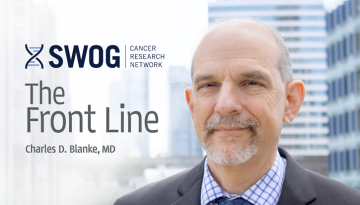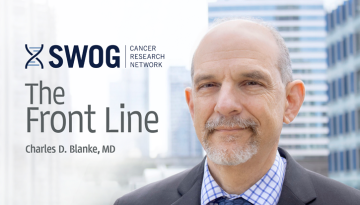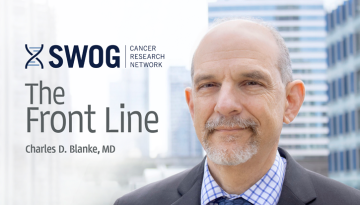Lung-MAP Shows Potential of Public-Private Partnerships
The unique public-private partnership that for almost a decade has undergirded the first National Cancer Institute (NCI)-sponsored precision medicine clinical trial in lung cancer can serve as a model for future clinical research that is more rapid, innovative, and inclusive.
Three members of the team that conceived that trial – the Lung Cancer Master Protocol, or Lung-MAP – discuss lessons learned from this partnership in a special report just published in the journal Clinical Cancer Research.
The lead author is Roy S. Herbst, MD, PhD, deputy director of Yale Cancer Center, chief of medical oncology at Yale Cancer Center and Smilow Cancer Hospital, and Ensign Professor of Medicine and assistant dean for translational research at Yale School of Medicine.
“Lung-MAP is a unique public-private partnership that has increased the access to new treatment options for patients with lung cancer across the country, including patients in rural communities and from diverse populations. It’s important that we now replicate the success of Lung-MAP in other cancer types so we can quickly move innovative science into clinical trials and benefit our patients,” said Herbst, who was one of the original principal investigators on Lung-MAP and has served as steering committee chair for the last decade.
Lung-MAP, and the partnership that spawned it, grew out of a need for new models for clinical trials that would rapidly and efficiently test therapies that targeted the specific molecular and genomic characteristics of each patient’s tumor.
Starting in 2012, a broad collaboration of experts and stakeholders from academia, government, industry, and patient advocacy came together to develop the protocol as a sustainable infrastructure for testing precision medicine advances in treating non-small cell lung cancer.
This collaboration now includes the NCI – part of the National Institutes of Health (NIH) – SWOG Cancer Research Network, Friends of Cancer Research, the Foundation for the National Institutes of Health, Foundation Medicine, pharmaceutical companies that provide their drugs for the study, several lung cancer advocacy organizations, and the other NCI National Clinical Trials Network groups that study cancers in adults.
The authors identify some key attributes that have made the Lung-MAP master protocol partnership successful:
- ensuring the trial evolves as the treatment and drug development landscape evolve requires close collaboration not only between researchers and drug companies but also between multiple drug companies
- potentially conflicting organizational cultures must be aligned to maximize efficiencies and share project leadership
- maintaining a pipeline of new drug candidates based on a rigorous, continuous vetting process is essential
- genomic sequencing data and sub-study biospecimens comprise a valuable resource for identifying new drug targets and exploring factors affecting disease response and treatment resistance
- the strengths of the partnership can be used to promote further innovation in clinical research – for example, a positive Lung-MAP sub-study led to a phase III confirmation study that is now the first pilot under the FDA’s Project Pragmatica
- a precision medicine master protocol can bring cutting-edge advances to a larger group of community-based treatment centers, which means broader patient access and a clinical trial that’s more inclusive than standard industry-run trials
This success of the Lung-MAP partnership in enrolling a more representative group of patients than traditional trials is detailed in a recent paper in JCO Precision Oncology (“Representativeness of Patients Enrolled in the Lung Cancer Master Protocol”). An accompanying editorial (“Clinical Trial Diversity: A Bend in the Arc Toward Justice”) highlights the trial’s unique public-private partnership as a key to this success and as a way forward for diversifying future industry trials.
“Lung-MAP brought together academia, advocacy, federal agencies, and industry, with a shared goal of bringing new advances in cancer treatment to all patients as quickly and safely as possible. I am proud of the achievements we’ve made together over the last decade and look forward to helping others model programs based on Lung-MAP’s success,” Herbst said.
The Lung-MAP trial is funded by the NCI/NIH through grants CA180888, CA180819, CA180820, CA180821, and CA180868 and in part by AbbVie, Amgen, AstraZeneca, Bristol Myers Squibb Company, Genentech, and Pfizer through the Foundation for the National Institutes of Health, in partnership with Friends of Cancer Research.
In addition to Herbst, coauthors on the report are Charles D. Blanke, MD, SWOG Cancer Research Network and Oregon Health and Science University, and Ellen V. Sigal, PhD, Friends of Cancer Research.
Reference:
Herbst RS, Blanke CD, Sigal EV. “Novel Approach to Accelerate Lung Cancer Research: Lung-Map and the Potential of Public-Private Partnerships.” DOI: 10.1158/1078-0432.CCR-23-2690 Clinical Cancer Research (2023). Published Nov 21, 2023. Open Access
Other Recent Stories



